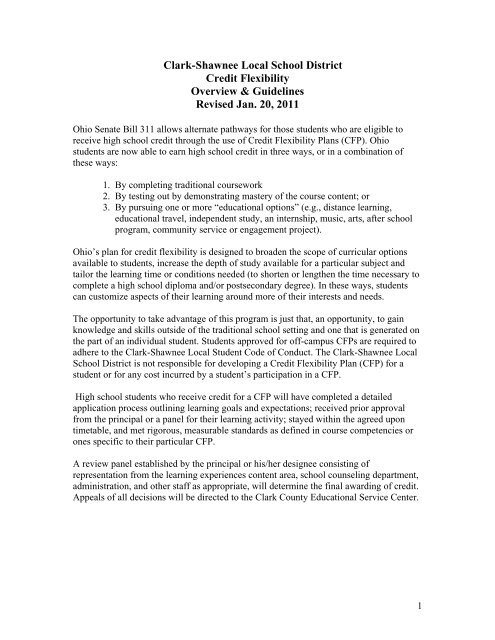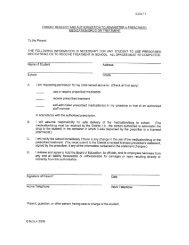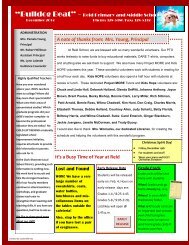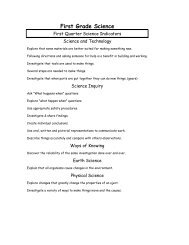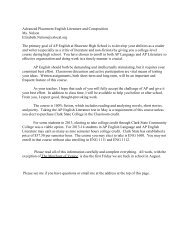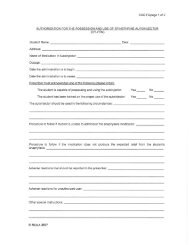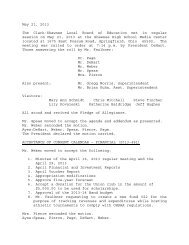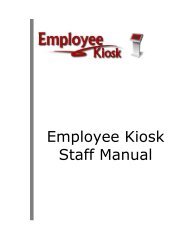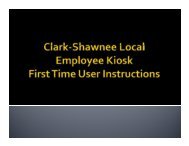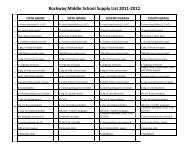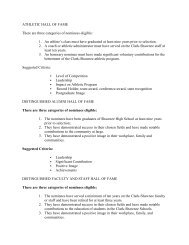credit flex program - Clark-Shawnee Local School District
credit flex program - Clark-Shawnee Local School District
credit flex program - Clark-Shawnee Local School District
Create successful ePaper yourself
Turn your PDF publications into a flip-book with our unique Google optimized e-Paper software.
<strong>Clark</strong>-<strong>Shawnee</strong> <strong>Local</strong> <strong>School</strong> <strong>District</strong><br />
Credit Flexibility<br />
Overview & Guidelines<br />
Revised Jan. 20, 2011<br />
Ohio Senate Bill 311 allows alternate pathways for those students who are eligible to<br />
receive high school <strong>credit</strong> through the use of Credit Flexibility Plans (CFP). Ohio<br />
students are now able to earn high school <strong>credit</strong> in three ways, or in a combination of<br />
these ways:<br />
1. By completing traditional coursework<br />
2. By testing out by demonstrating mastery of the course content; or<br />
3. By pursuing one or more “educational options” (e.g., distance learning,<br />
educational travel, independent study, an internship, music, arts, after school<br />
<strong>program</strong>, community service or engagement project).<br />
Ohio’s plan for <strong>credit</strong> <strong>flex</strong>ibility is designed to broaden the scope of curricular options<br />
available to students, increase the depth of study available for a particular subject and<br />
tailor the learning time or conditions needed (to shorten or lengthen the time necessary to<br />
complete a high school diploma and/or postsecondary degree). In these ways, students<br />
can customize aspects of their learning around more of their interests and needs.<br />
The opportunity to take advantage of this <strong>program</strong> is just that, an opportunity, to gain<br />
knowledge and skills outside of the traditional school setting and one that is generated on<br />
the part of an individual student. Students approved for off-campus CFPs are required to<br />
adhere to the <strong>Clark</strong>-<strong>Shawnee</strong> <strong>Local</strong> Student Code of Conduct. The <strong>Clark</strong>-<strong>Shawnee</strong> <strong>Local</strong><br />
<strong>School</strong> <strong>District</strong> is not responsible for developing a Credit Flexibility Plan (CFP) for a<br />
student or for any cost incurred by a student’s participation in a CFP.<br />
High school students who receive <strong>credit</strong> for a CFP will have completed a detailed<br />
application process outlining learning goals and expectations; received prior approval<br />
from the principal or a panel for their learning activity; stayed within the agreed upon<br />
timetable, and met rigorous, measurable standards as defined in course competencies or<br />
ones specific to their particular CFP.<br />
A review panel established by the principal or his/her designee consisting of<br />
representation from the learning experiences content area, school counseling department,<br />
administration, and other staff as appropriate, will determine the final awarding of <strong>credit</strong>.<br />
Appeals of all decisions will be directed to the <strong>Clark</strong> County Educational Service Center.<br />
1
<strong>Shawnee</strong> High <strong>School</strong> Credit Flexibility Application<br />
Eligible Credit Flexibility Plans<br />
Credit Flexibility Plans (CFP) are educational experiences where the primary acquisition<br />
of knowledge and skills takes place outside of a traditional classroom setting. These<br />
opportunities may include but not be limited to: independent study, private instruction,<br />
performing groups, internships, community service, apprenticeship, work-study and<br />
online courses. The <strong>Clark</strong>-<strong>Shawnee</strong> <strong>Local</strong> <strong>School</strong> <strong>District</strong> is not responsible for any cost<br />
incurred from a student’s participation in a CFP during the 2010-2011 school year.<br />
Students are required to have prior approval for the CFP before the experience is<br />
initiated.<br />
A team of subject related school personnel, by appointment of the principal or his/her<br />
designee, would comprise a review panel. Their role will be to approve and set<br />
expectations utilizing the CFP Review Panel Assessment Report (see page 10).<br />
At the conclusion of the experience, mastery of learning objectives must be demonstrated<br />
as defined by the approved CFP.<br />
Earned Credit from Credit Flexibility Plans<br />
Students may use a CFP to earn <strong>credit</strong> and/or gain promotion in a course sequence. High<br />
schools will award a maximum of 1 <strong>credit</strong> for an individual CFP. Exceptions may be<br />
granted to students on a case-by-case basis approved by the principal or his/her designee.<br />
Earned <strong>credit</strong> for a CFP will be based on rigorous and measurable standards as defined in<br />
course competencies and student expectations outlined in the approved CFP. Successful<br />
completion of a CFP will be documented on a student’s transcript in a manner as <strong>credit</strong><br />
earned traditionally.<br />
Choice of Testing Out Process:<br />
Traditional: Student and parent schedule a meeting with principal or guidance<br />
counselor to present the completed application for Testing Out (page 12) with payment.<br />
($80 per course) The principal or guidance counselor will present the student with a<br />
course syllabus, course textbook, and make the course workbook available for the<br />
students at student’s cost (if applicable). The student will be required to take assessments<br />
established for each course which may include any of the following: semester and final<br />
exams, performance assessment tasks, and quarterly assessments. Student must make<br />
arrangement for testing within the agreed to timelines as outlined in the application.<br />
Advance Placement Testing for high school <strong>credit</strong>: Students who score a 3, 4 or 5 and<br />
provided the verification letter to the high school qualify for high school <strong>credit</strong> in the<br />
respective Advanced Placement Test. Advanced Testing Exams are scheduled by the<br />
National Testing Service for a specific national testing date and time in May. Interested<br />
2
students must contact the AP Testing Coordinator and/or their high school guidance<br />
counselor prior to March 15 th . The cost for an AP Test is $90 (2010) and must be paid<br />
when the test is requested. Students who qualify for Free and Reduced Lunch may<br />
qualify for cost reductions and may identify themselves as eligible prior to making<br />
arrangements to pay for the test. For more information go to<br />
http://www.col1egeboard.com/student/testing/ap/cal/cal2.html or call 877-225-5427.<br />
Application Process<br />
A student considering a CFP should discuss the possibility with his/her school counselor<br />
and teachers early in the process. It is expected that the formal proposal will be<br />
thoroughly and thoughtfully researched. A completed application will be submitted<br />
directly to the guidance office. CFP applications must be submitted for approval during<br />
the first full school week of May or January to be considered for the following semester.<br />
1. The application is to be completed by the student/parent/guardian seeking<br />
approval for the <strong>credit</strong> <strong>flex</strong> plan.<br />
2. The application must be completed and submitted by timelines listed above for<br />
consideration. However, the Board recognizes that short-term notice opportunities<br />
may present themselves to students from time to time. As such, the principal may<br />
grant waivers to the timeline submission requirement at his/her discretion,<br />
provided all other application criteria are satisfied. Such waivers will be granted<br />
on a case-by-case basis. All required information must be attached to the<br />
application and submitted to the principal.<br />
3. The application will be reviewed by the CFP Review Panel and a decision will be<br />
made within fifteen (15) school days of the close of the application process. The<br />
student will be notified in writing of the status of the application. If additional<br />
information is requested, the information must be submitted within one week of<br />
the request.<br />
4. It is the student’s responsibility to maintain academic standing and enrollment in<br />
the approved <strong>program</strong>. Any failure to complete an approved <strong>program</strong> may<br />
jeopardize the student’s ability to earn <strong>credit</strong> for the course. The student and<br />
parent/guardian recognize that in the event the student withdraws from an<br />
approved <strong>program</strong>, the high school cannot guarantee placement in an equivalent<br />
district-offered course.<br />
Newly Enrolled Students<br />
Students newly enrolled in the <strong>Clark</strong>-<strong>Shawnee</strong> <strong>Local</strong> <strong>School</strong> <strong>District</strong> after the established<br />
timelines for application submission will have 10 school days to submit a CFP for<br />
approval. Students who were working under a CFP at their previous school may submit<br />
that plan within 10 days of enrolling in the <strong>Clark</strong>-<strong>Shawnee</strong> <strong>Local</strong> <strong>School</strong> <strong>District</strong>.<br />
Approval of CFPs from other districts is not guaranteed. Plans that are not approved are<br />
3
eligible for the appeal process as outlined.<br />
Timeline<br />
Students who do not complete the requirements of the CFP in the agreed upon time frame<br />
may request an extension in writing to the principal. The request will be reviewed by the<br />
review panel who will notify the student, parent, and school counselor of the panel’s<br />
decision regarding the request.<br />
Final Evaluation Guidelines<br />
A CFP may take on a variety of experiences; therefore, there is no single method of final<br />
evaluation. Final evaluations will be determined during the application process and may<br />
include a panel presentation by the student, a research paper, a demonstration, a final<br />
course grade, a final project or artifact, a portfolio, a performance, or mastery<br />
performance on a core competency assessment, such as quarterly assessments, course<br />
tests or semester and final exams. The final evaluation for any CFP that results in a<br />
product to be assessed by the Review Panel will be determined by the average of all<br />
rubric (or similar) scores used by the Review Panel. A copy of the evaluative rubric will<br />
be made available at the time of CFP approval. A copy of all submissions will become<br />
the property of the high school.<br />
Students choosing the testing out process to gain <strong>credit</strong> under a CFP will follow the<br />
requirements established by the <strong>Shawnee</strong> High <strong>School</strong> faculty for each course. The<br />
student may be expected to take the semester and final exams as well as the two short<br />
cycle assessments for the core area courses or two tests for the noncore area courses<br />
within the 60 day timeline listed on the application. The student’s grade will be<br />
determined by averaging the grades from all of the tests/tasks/assignments completed. A<br />
minimum grade of 80% is required in order for the student to earn <strong>credit</strong> and/or be<br />
promoted to the next course in the sequence.<br />
Students who complete an approved CFP but are unable to demonstrate content mastery<br />
through their Final Evaluation may submit an alternate CFP or may schedule into a<br />
corresponding traditional course, if available. A failed CFP will appear on the student’s<br />
transcript as a failed attempt at the course.<br />
Program Integrity<br />
In order to ensure the integrity of the learning experience approved under this <strong>program</strong>,<br />
the student will be required periodically or upon demand to provide evidence of progress<br />
and attendance. The principal will be responsible for certifying course completion and the<br />
award of <strong>credit</strong>s consistent with the <strong>Clark</strong>-<strong>Shawnee</strong> <strong>Local</strong> <strong>School</strong> <strong>District</strong> policy on<br />
graduation.<br />
If a student is unable to complete the CFP for valid reasons, the principal or his/her<br />
designee, or assigned certified teacher will evaluate the experience completed to date and<br />
4
may recommend an alternative experience to enable the student to earn the <strong>credit</strong>.<br />
If a student ceases to attend or is unable to complete the CFP for insufficient reasons<br />
(lack of effort, failure to follow through, indecision, etc,), the principal may determine<br />
that the student’s transcript be adjusted to reflect the experience as a failure.<br />
In order to certify completion of co-curricular <strong>program</strong>s and activities based upon<br />
specific instructional objectives aligned to the standards, the school will develop<br />
appropriate mechanisms to document student progress and <strong>program</strong> completion on<br />
student personnel records.<br />
Appeals<br />
Appeals of all decisions must be made in writing to: <strong>Clark</strong> County Superintendent, 25 W.<br />
Pleasant Street, Springfield, Ohio 45506 no later than seven (7) calendar days after<br />
notification of a <strong>Clark</strong>-<strong>Shawnee</strong> <strong>Local</strong> decision. Appeals will be heard at the next regular<br />
meeting of the <strong>Clark</strong> County Superintendents. Decisions of the <strong>Clark</strong> County<br />
Superintendents review panel shall be final.<br />
5
Guidelines for CFP Final Evaluation<br />
The following are examples of CFP final evaluations. Students may use one or more of<br />
these summative assessments to demonstrate learning from the CFP experience.<br />
Panel Presentations:<br />
Research Paper:<br />
Demonstration:<br />
Course Grade:<br />
Project or Artifact:<br />
Portfolio:<br />
Performance:<br />
Core Competency:<br />
The student will be required to explain his/her project and<br />
its outcome in detail to the panel. Student learning as well<br />
as presentation skills will be part of the evaluation.<br />
The student will be required to submit to the panel a<br />
research paper which meets the specific criteria (to include<br />
content, reference, and format) agreed upon at the time of<br />
the CFP approval.<br />
The student will be required to make an outward<br />
display or show by example to the panel what knowledge<br />
and/or skills were acquired through the CFP.<br />
The student will provide an official transcript from<br />
the ac<strong>credit</strong>ed school. A minimum grade of 80% is required<br />
in order for the student to earn <strong>credit</strong> and/or be promoted to<br />
the next course in the sequence. As an example, a grade of<br />
80% or better will be required for the student to earn <strong>credit</strong><br />
for Algebra I and move on to Geometry.<br />
The student will present a final project or artifact of<br />
his/her learning opportunity to the panel and answer<br />
questions specific to the process and the final product.<br />
The student will submit artifacts, reproductions,<br />
productions, learning log, and/or reflections in an organized<br />
and focused format to provide evidence of learning that<br />
meets the criteria established at the time of CFP approval.<br />
A portfolio may be a required component of other<br />
methods used to demonstrate learning. See the following<br />
page for portfolio recommendations.<br />
The student will demonstrate learning through a<br />
performance assessment determined by the review panel at<br />
the time of CFP approval.<br />
In courses where there is an existing core course<br />
competency, the student may demonstrate learning through<br />
the final competency assessments (Exams and Tests).<br />
6
Guidelines for Portfolio Development<br />
The following components are essential to the development of an assessment portfolio.<br />
Table of Contents<br />
Project Proposal<br />
Assessment Criteria<br />
Mentor Assessment<br />
Evidence<br />
Reflection<br />
The portfolio’s table of contents will give the student and reader a<br />
view of the entire collection.<br />
The student will provide a detailed description of his/her project.<br />
The purpose and goals of the project must be clearly defined. The<br />
narrative will include the purpose of the project, supporting<br />
research, references, educational goals, and evidence of alignment<br />
with academic content standards.<br />
The student and the review panel will have to determine what<br />
evidence will be sufficient to document learning. An assessment<br />
rubric must be included as part of the portfolio.<br />
Mentor final assessment (if applicable)<br />
When collecting evidence of learning, select items that add new<br />
information related to the attainment of the learning goals. The<br />
collection of artifacts must be well organized and represent best<br />
efforts of the participant. Evidence can include learning logs,<br />
documentation of interviews or activities, statements and<br />
observations about the participant, drawings, photos, laboratory<br />
results, video, audio, written work samples, copies of specific tests,<br />
data, reading logs, self-assessment, a log of clock hours etc. It may<br />
be pertinent for the student to include evidence documenting<br />
growth over time toward mastery of a goal.<br />
The student will show thoughtful reflection and evaluation of<br />
his/her CFP. The student will discuss how this learning opportunity<br />
fits his/her personal learning style. The student will include in<br />
his/her discussion the high and low points of the experience and<br />
how the experience could be improved upon. The student will<br />
discuss how he/she may have modified his/her initial goals and<br />
what resources were particularly helpful. The student will include<br />
how he/she will apply the new skills or knowledge to real-life<br />
situations.<br />
7
Credit Flexibility Plan (CFP) Application<br />
Credit Flexibility Plans (CFP) are educational experiences where the primary acquisition of<br />
knowledge and skills takes place outside of the <strong>Clark</strong>-<strong>Shawnee</strong> <strong>Local</strong> <strong>School</strong> <strong>District</strong> classrooms.<br />
These opportunities may include but not be limited to: independent study, private instruction,<br />
performing groups, internships, community service, apprenticeship, work-study, and online courses.<br />
Please complete the following application in detail using the online form<br />
available at the district website. Attach any additional documentation you feel will clarify<br />
your proposal. This application is to be submitted directly to the principal or his/her<br />
designee. Please be thorough in your application; lack of detail may affect approval.<br />
Name:_______________________________________________ Grade: _____________<br />
Home Address:_________________________________________________________________<br />
Home Telephone Number: _____________________Email: __________________________<br />
Project Title: ____________________________________ Cell Phone: ________________________<br />
Credit To Be Earned:_____________<br />
<strong>School</strong> Counselor Name: _________________________________<br />
Is this your first CFP? Have you already earned CFP <strong>credit</strong> for another project/learning<br />
experience? Explain.<br />
Project Description: Describe the project/learning experience in detail. What are the<br />
personal learning goals which you hope to achieve by this opportunity?<br />
Project Rationale: Explain how this will be a valuable learning experience for you.<br />
List and explain what competencies you will achieve through this learning experience?<br />
8
Name of the private institution or mentor: As it applies, attach documentation of<br />
ac<strong>credit</strong>ation of the <strong>program</strong>, a course syllabus, and instructor credentials. Please include<br />
a letter from your mentor stating that he/she understands and agrees to the role they will<br />
perform in this process.<br />
What assistance do you expect from your mentor?<br />
What assistance do you expect from the high school?<br />
What materials, supplies, and resources will you use?<br />
Tentative timeline and completion date for this learning experience: Break down your<br />
project into small timeframes. What measurable outcomes will be expected at each<br />
check-in point? (This is very important for athletic eligibility)<br />
How do you plan to demonstrate your learning?<br />
Signatures required: Your signature documents that you have read the CFP application<br />
and agree with the purpose and contents of this specific proposal.<br />
Student:______________________________________ Date:__________<br />
Parent/Guardian:_______________________________ Date:__________<br />
Guidance Counselor: ___________________________ Date: __________<br />
9
Review Panel Assessment Report<br />
Student Name:<br />
__________________<br />
Project:______________________________________________________<br />
1) Does the high school offer a prerequisite or another course in this course sequence?<br />
2) How many <strong>credit</strong>s will be awarded for this CFP? If different from number requested,<br />
explain your decision.<br />
3) Does this course have a Course of Study and/or End-of-Course Exam? If yes, will this<br />
learning experience meet the pre-established competencies? Will the student complete the<br />
End-of Course Exam?<br />
4) Are you satisfied with the way the student plans to demonstrate learning?<br />
5) Who, in addition to the Review Panel, will evaluate this CFP?<br />
6) Do you have recommendations for changes to the proposal and/or additional<br />
requirements?<br />
7) If applicable, attach the rubric which will be used in the evaluation.<br />
Credit Flexibility Plan: Approved ____Not Approved _______Date________<br />
Signatures of Review Panel:<br />
Name (Print) Signature Date<br />
___________________________ ___________________________ _________<br />
___________________________ ___________________________ _________<br />
___________________________ ___________________________ _________<br />
___________________________ ___________________________ _________<br />
___________________________ ___________________________ _________<br />
___________________________ ___________________________ _________<br />
___________________________ ___________________________ _________<br />
If, as a team, you have determined that this CFP proposal cannot be approved,<br />
clearly state why this proposal has been rejected.<br />
Credit Flexibility Plan (CFP)<br />
Mentor Responsibilities and Report (if applicable)<br />
10
Credit Flexibility Plans (CFP) are educational experiences where the primary<br />
acquisition of knowledge and skills takes place outside of the high school’s<br />
classrooms. These opportunities may include but not be limited to: independent<br />
study, private instruction, performing groups, internships, community service,<br />
apprenticeship, work study, and online courses. You have agreed to mentor a student<br />
through their CFP process. Please complete the following form which will be part of<br />
the student’s final evaluation.<br />
Your Name: ____________________________________Title: __________________________<br />
Name of student:_______________________________<br />
Date:___________________________<br />
1)Briefly describe your role as Mentor for this project. How did you assist the student? What<br />
was asked of you? How were your talents used?<br />
2)Briefly describe how well the student followed the process for the project. Did the student meet<br />
deadlines? Did the student complete all the required work?<br />
3)In your opinion, what were the student’s strengths and weakness as they relate to this project?<br />
4)Are you familiar with the national and state standards for this particular area of study? If yes,<br />
did the student meet the objectives?<br />
5)For what reasons would you pass or fail this student’s project?<br />
Mentor Name: ___________________________________ Position: _________________<br />
Mentor Address: ______________________________________ Phone: ______________<br />
Mentor Signature:_______________________________________________ Date:___________<br />
Final Grade __________________<br />
11
<strong>Clark</strong>-<strong>Shawnee</strong> <strong>Local</strong> <strong>School</strong> <strong>District</strong><br />
Test-Out Application<br />
Student:_______________________________ Grade__________ Date____________<br />
Address________________________________________, Ohio Zip _____________<br />
Home Phone:___________________________ Cell Phone:_____________________<br />
Parent or Guardian Signature:___________________________________________<br />
Principal Signature:____________________________________________________<br />
Guidance Counselor Signature:__________________________________________<br />
Course Requested:_____________________________________________________<br />
Payment Method ($80) Check#_________ Cash_____ Receipt#_______________<br />
Timeline for Start and Completion:______________________________________<br />
Grades: Semester Exam_________________ Final Exam_________________________<br />
1st Nine Weeks QA_____________ 3rd Nine Weeks QA___________________<br />
Other ____________________________________________________________<br />
Final Grade:____________________(Must be 80% or better to get <strong>credit</strong>)<br />
Traditional: Student and parent schedule a meeting with the principal or guidance counselor<br />
to present the completed application for Testing Out with payment. ($80 per course) The<br />
principal or guidance counselor will present the student with a course syllabus, course textbook,<br />
and make the course workbook available for the students at student’s cost (if applicable). The<br />
student will be required to take the semester and final exams as well as other established<br />
assessments and/or performance tasks. Student must make arrangement for testing within the<br />
agreed to timelines of the testing out process.<br />
Advance Placement Testing for high school <strong>credit</strong>: Students who score a 3, 4 or 5 and<br />
provided the verification letter to the high school, qualify for high school <strong>credit</strong>. Advanced<br />
Testing Exams are scheduled by the National Testing Service for a specific national testing date<br />
and time in May. Interested students must contact the AP Testing Coordinator (high school<br />
guidance counselor) prior to March 15 th . The cost for an AP Test is $90 (2010) and must be paid<br />
when the test is requested. Students who qualify for Free and Reduced Lunch may qualify for<br />
cost reductions and may identify themselves as eligible prior to making arrangements to pay for<br />
the test. For more information go to<br />
http://www.col1egeboard.com/student/testing/ap/cal/cal2.html or call 877-225-5427.<br />
12


